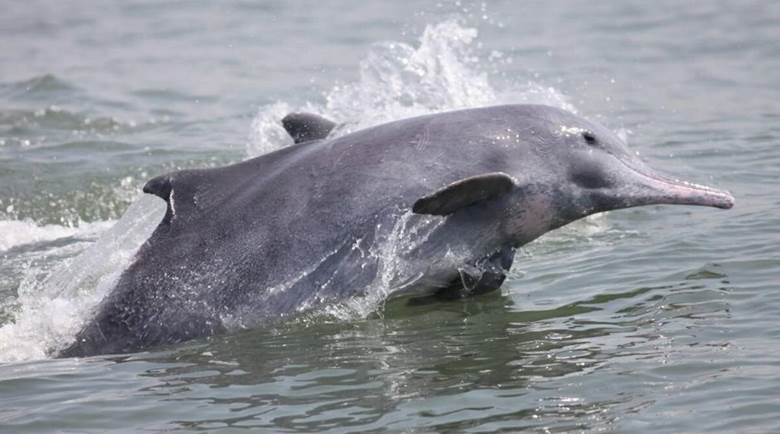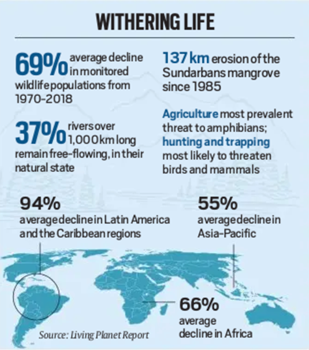LIVING PLANET REPORT 2022

Copyright infringement not intended
Context: Monitored wildlife populations — including mammals, birds, amphibians, reptiles and fish — have seen a 69-per cent drop between 1970 and 2018, according to the latest Living Planet Report, released by the World Wildlife Fund (WWF).
Details:
Findings:
- Stating that there has been “an average 69% decline in monitored wildlife populations over the 48-year period” up to 2018, the report stated: Latin America and the Caribbean regions have seen the largest decline of monitored wildlife populations globally, with an average decline of 94% between 1970 and 2018.
- During the same period, monitored populations in Africa plummeted by 66%, while Asia Pacific’s monitored populations fell by 55%.
- The WWF has found that freshwater populations have declined the most, with an average 83% decline between 1970 and 2018.
- The IUCN Red List shows cycads — an ancient group of seed plants — are the most threatened species, while corals are declining the fastest, followed by amphibians.
- Around the world…the main drivers of wildlife population decline are habitat degradation and loss, exploitation, the introduction of invasive species, pollution, climate change and disease.
- Land-use change is still the biggest current threat to nature, destroying or fragmenting the natural habitats of many plant and animal species on land, in freshwater and in the sea.
- However, if we are unable to limit warming to 1.5°C, climate change is likely to become the dominant cause of biodiversity loss in the coming decades.
- About 50% of warm water corals have already been lost and a warming of 1.5 degrees Celsius will lead to a loss of 70-90% warm water corals. The Bramble Cay melomys, a small Australian rodent, was declared extinct after sea-level rise.
- Despite their importance, mangroves continue to be deforested by aquaculture, agriculture and coastal development at a rate of 0.13% annually, the report noted. It stated that many mangroves are degraded by over-exploitation and pollution, alongside natural stressors such as storms and coastal erosion.
- Only 37% of rivers that are over 1,000 km long remain free-flowing, or in their natural state, including rivers in India that are largely no longer free-flowing. This, the report noted, has threatened migration of fish.
- The Living Planet Report has found that agriculture is the most prevalent threat to amphibians (animals that live both on land and in water), whereas hunting and trapping are most likely to threaten birds and mammals.
- Geographically, Southeast Asia is the region where species are most likely to face threats at a significant level, while the Polar regions and the east coast of Australia and South Africa showed the highest impact probabilities for climate change, driven in particular by impact on birds.
- The global abundance of 18 of 31 oceanic sharks have declined by 71% over the last 50 years, and the report said that by 2020 three-quarters of sharks and rays were threatened with extinction.

India specific:
- According to WWF-India programme, the country has seen a decline in population of the likes of honeybees and 17 species of freshwater turtles in this period.
- The report finds that the Himalayan region and the Western Ghats are some of the most vulnerable regions in the country in terms of biodiversity loss, and where increased biodiversity loss is expected in future if temperatures are to increase.
- Projects like the recent cheetah translocation are therefore good in preservation of species, and India has seen successes such as Project Tiger, or (projects for) the one-horned rhino and lions. There is an umbrella effect on all other species living in that habitat due to conservation of these species.
About:
- The biennial report, produced by the Zoological Society of London, measures how species are responding to pressure in the environment due to biodiversity loss and climate change.
- This year’s report has tracked 32,000 species populations of 5,230 species, with 838 species and just over 11,000 new populations added.
- There has been a significant increase in the number of fish species (481) that have been added to the Living Planet Report.
World Wildlife Fund for Nature:
- It is the world’s leading conservation organization and works in more than 100 countries.
- It was established in 1961 and is headquartered at Gland, Switzerland.
- Its mission is to conserve nature and reduce the most pressing threats to the diversity of life on Earth.
- WWF collaborates at every level with people around the world to develop and deliver innovative solutions that protect communities, wildlife, and the places in which they live.
Zoological Society of London: Founded in 1826, Zoological Society of London is an international conservation charity working for wildlife conservation.




1.png)
